service Oldsmobile Aurora 1998 s Owner's Guide
[x] Cancel search | Manufacturer: OLDSMOBILE, Model Year: 1998, Model line: Aurora, Model: Oldsmobile Aurora 1998Pages: 380, PDF Size: 19.75 MB
Page 226 of 380
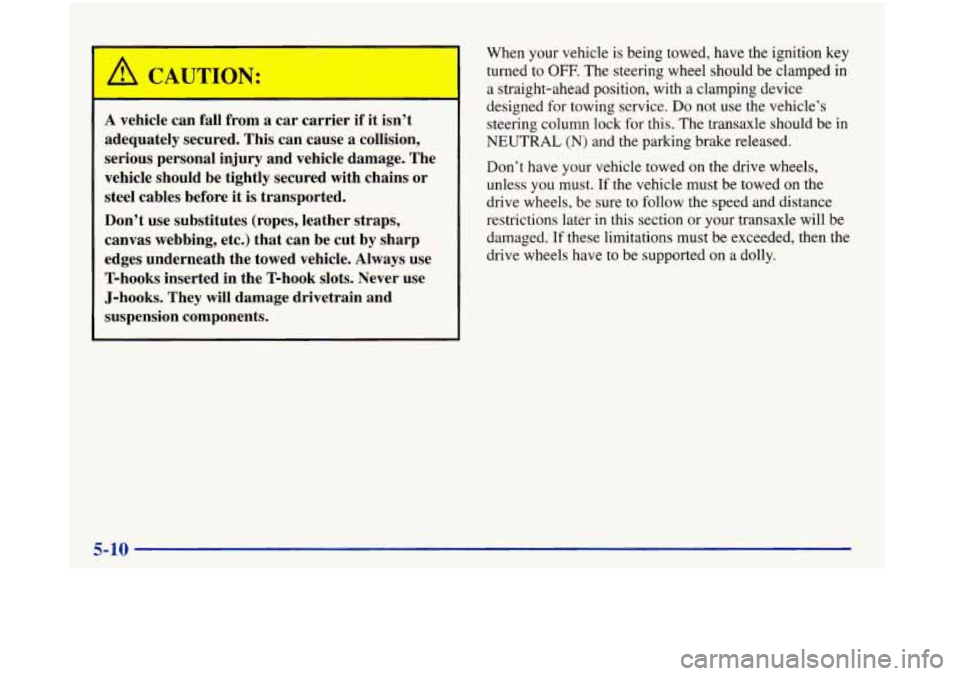
r
U
A vehicle can fall from a car carrier if it isn’t
adequately secured. This can cause a collision,
serious personal injury and vehicle damage. The
vehicle should be tightly secured with chains or
steel cables before it
is transported.
Don’t use substitutes (ropes, leather straps,
canvas webbing, etc.) that can be cut by sharp
edges underneath the towed vehicle. Always use
T-hooks inserted in the T-hook slots. Never use
J-hooks.
They will damage drivetrain and
suspension components.
When your vehicle is being towed, have the ignition key
turned to
OFF. The steering wheel should be clamped in
a straight-ahead position, with a clamping device
designed for towing service.
Do not use the vehicle’s
steering column lock for this. The transaxle should be in
NEUTRAL (N) and the parking brake released.
Don’t have your vehicle towed on the drive wheels, unless
you must. If the vehicle must be towed on the
drive wheels, be sure
to follow the speed and distance
restrictions later in this section or your transaxle will be
damaged. If these limitations must be exceeded, then the
drive wheels have to be supported on a dolly.
5-10
Page 232 of 380

If No Steam - Coming From Your Engine
If you get the overheat warning but see or hear no
steam, the problem may not be too serious. Sometimes
the engine can get a little too hot when you:
Climb a long hill on a hot day.
Stop after high-speed driving.
Idle for long periods in traffic.
Tow a trailer.
If
you get the overheat warning with no sign of steam,
try this for a minute or
so:
1. Turn off your air conditioner.
2. Turn on your heater to full hot at the highest fan
speed and open the window as necessary.
3. If you’re in a traffic jam, shift to NEUTRAL (N);
otherwise, shift to the highest gear while
driving
-- AUTOMATIC OVERDRIVE (a) or
THIRD
(3).
If you no longer have the overheat warning,
you can drive. Just to be safe, drive slower for
about
10 minutes. If the warning doesn’t come back on,
you can drive normally.
If the warning continues, pull over, stop, and park your
vehicle right away.
If there’s still no sign of steam,
you can idle the engine
for two or three minutes while you’re parked, to
see if
the warning stops. But then, if
you still have the
warning,
turn ofthe engine and get everyone out of the
vehicle until it cools down. Also, see “Overheated
Engine Protection Operating Mode” listed previously in
this section.
You may decide not to lift the hood but to get service
help right away.
5-16
Page 234 of 380
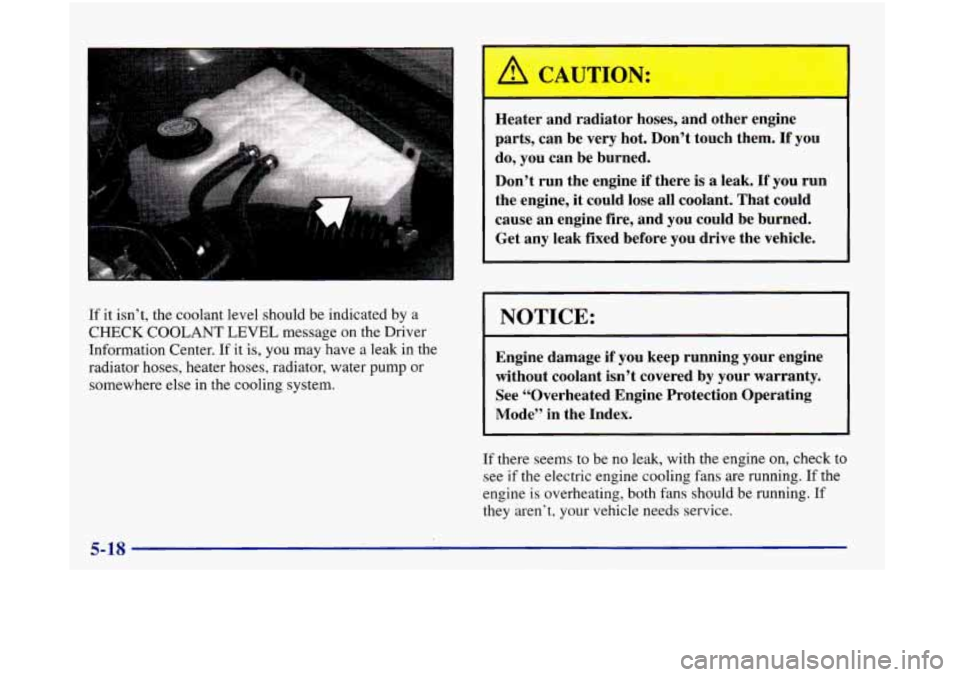
Heater and radiator hoses, and other engine
parts, can be very hot. Don’t touch them. If you
do, you can be burned.
Don’t run the engine if there is
a leak. If you run
the engine, it could lose
all coolant. That could
cause an engine fire, and you could be burned.
Get any leak fixed before you drive the vehicle.
If it isn’t, the coolant level should be indicated by a
CHECK COOLANT LEVEL message on the Driver
Information Center.
If it is, you may have a leak in the
radiator hoses, heater hoses, radiator, water
pump or
somewhere else in the cooling system,
NOTICE:
Engine damage if you keep running your engine
without coolant isn’t covered by your warranty.
See “Overheated Engine Protection Operating
Mode” in the Index.
If there seems to be no leak, with the engine on, check to
see
if the electric engine cooling fans are running. If the
engine
is overheating, both fans should be running. If
they aren’t, your vehicle needs service.
5-18
Page 253 of 380
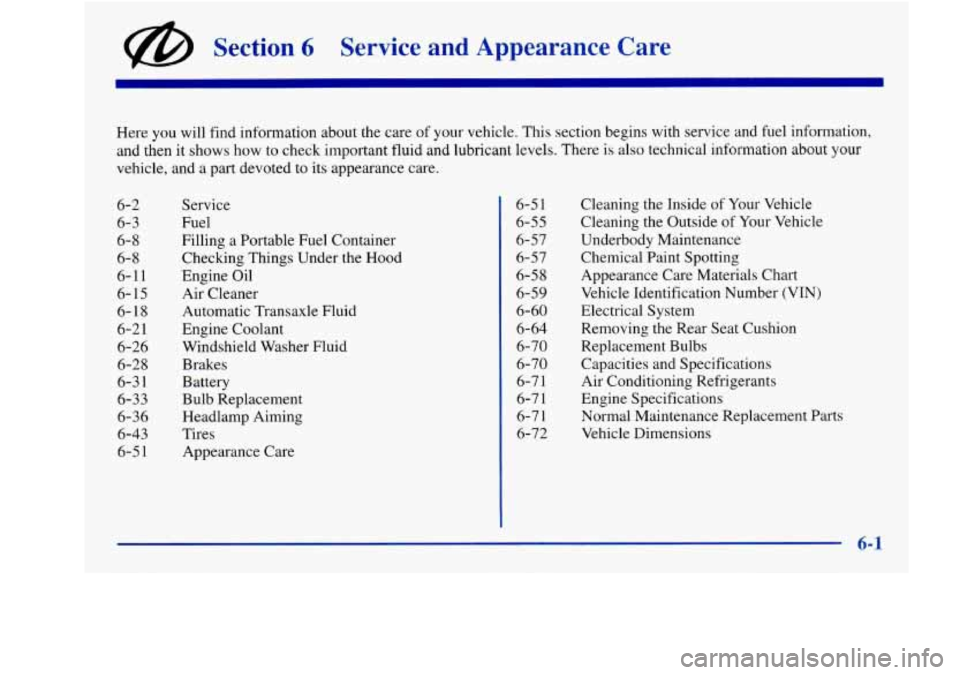
@ Section 6 Service and Appearance Care
Here you will find information about the care of your vehicle. This section begins with service and fuel information,
and then it shows
how to check important fluid and lubricant levels. There is also technical information about your
vehicle, and a part devoted to its appearance care.
6-2 6-3
6- 8
6- 8
6-11
6- 15
6-18
6-2 1
6-26
6-28
6-3
1
6-33
6-36
6-43
6-5 1 Service
Fuel
Filling a Portable Fuel Container
Checking Things Under the Hood
Engine Oil
Air Cleaner Automatic Transaxle Fluid
Engine Coolant
Windshield Washer Fluid
Brakes
Battery Bulb Replacement
Headlamp Aiming
Tires Appearance Care 6-5
1
6-55
6-57
6-57
6-58
6-59
6-60
6-64 6-70
6-70
6-7 1
6-7
1
6-7 1
6-72 Cleaning the
Inside of Your Vehicle
Cleaning the Outside
of Your Vehicle
Underbody Maintenance Chemical Paint Spotting
Appearance Care Materials Chart
Vehicle Identification Number (VIN)
Electrical System
Removing the Rear Seat Cushion
Replacement Bulbs Capacities and Specifications
Air Conditioning Refrigerants
Engine Specifications
Normal Maintenance Replacement Parts Vehicle Dimensions
6-1
Page 254 of 380

Service
Your retailer knows your vehicle best and wants you to
be happy with it. We hope you’ll go to your retailer for
all your service needs. You’ll get genuine GM parts and
GM-trained and supported service people.
We hope you’ll want
to keep your GM vehicle all GM.
Genuine GM parts have one of these marks:
Genuine
Parts
Doing Your Own Service Work
If you want to do some of your own service work, you’ll
want to use the proper Aurora Service Manual. It tells
you much more about how to service your vehicle than
this manual can.
To order the proper service manual, see
“Service and Owner Publications” in the Index.
Your vehicle has an air bag system. Before attempting to
do your
own service work, see “Servicing Your Air
Bag-Equipped Vehicle” in
the Index.
You should keep
a record with all parts receipts and list
the mileage and the date of any service work you
perform. See “Maintenance Record” in the Index.
6-2
Page 255 of 380
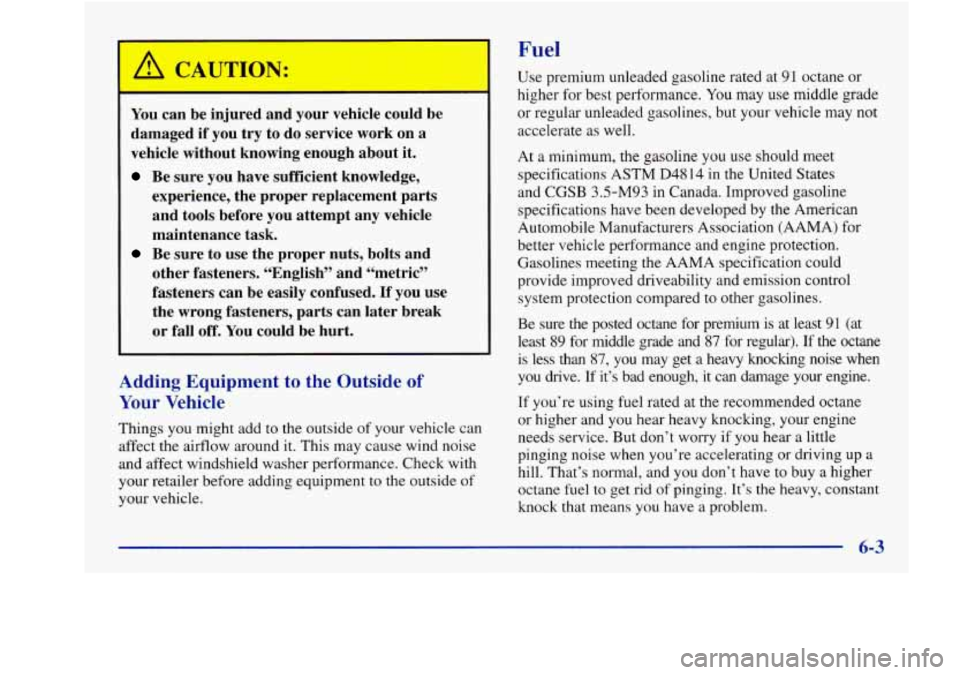
Fuel
You can be injured and your vehicle could be
damaged if you
try to do service work on a
vehicle without knowing enough about it.
Be sure you have sufficient knowledge,
experience, the proper replacement parts
and tools before you attempt any vehicle
maintenance task.
Be sure to use the proper nuts, bolts and
other fasteners. “English” and “metric”
fasteners can be easily confused.
If you use
the wrong fasteners, parts can later break
or fall off. You could be hurt.
Adding Equipment to the Outside of
Your Vehicle
Things you might add to the outside of your vehicle can
affect the airflow around it. This may cause wind noise
and affect windshield washer performance. Check with
your retailer before adding equipment to the outside of
your vehicle. Use premium unleaded
gasoline rated at 91 octane or
higher for best performance. You may use middle grade
or regular unleaded gasolines, but your vehicle may not
accelerate as well.
At a minimum, the gasoline
you use should meet
specifications ASTM
D4814 in the United States
and CGSB
3.5-M93 in Canada. Improved gasoline
specifications have been developed by the American
Automobile Manufacturers Association (AAMA) for
better vehicle performance and engine protection.
Gasolines meeting the AAMA specification could
provide improved driveability and emission control
system protection compared to other gasolines.
Be sure the posted octane for premium
is at least 91 (at
least 89 for middle grade and 87 for regular).
If the octane
is less than 87, you may get a heavy knocking noise when
you drive.
If it’s bad enough, it can damage your engine.
If you’re using fuel rated at the recommended octane
or higher and you hear heavy knocking, your engine
needs service. But don’t worry if you hear a little
pinging noise when you’re accelerating or driving up a
hill. That’s normal, and you don’t have to buy a higher
octane fuel to get rid
of pinging. It’s the heavy, constant
knock that means you have a problem.
Page 256 of 380
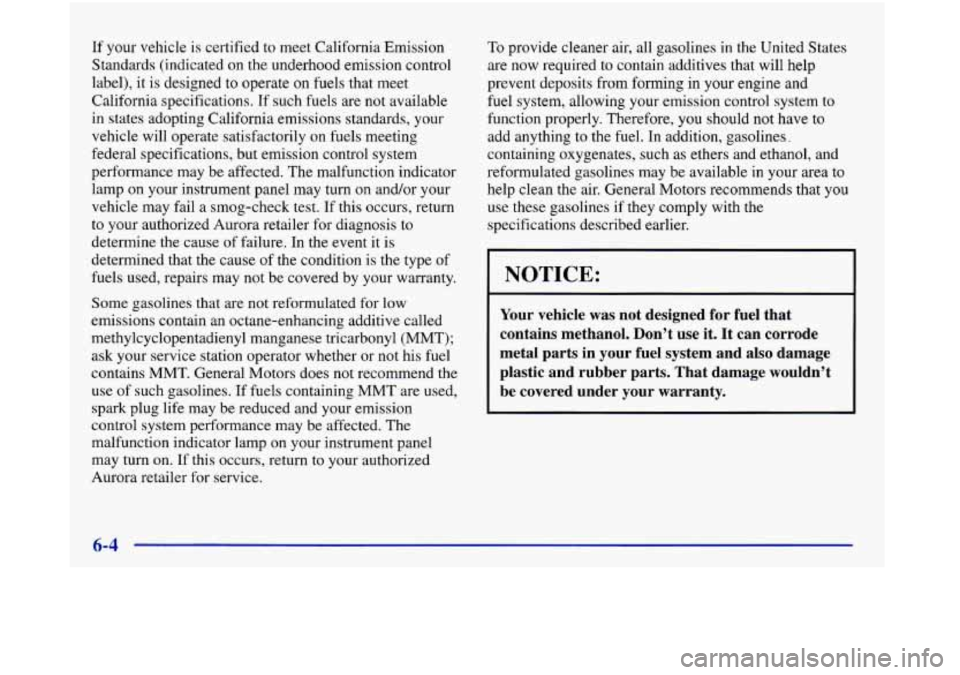
If your vehicle is certified to meet California Emission
Standards (indicated on the underhood emission control
label), it is designed to operate
on fuels that meet
California specifications.
If such fuels are not available
in states adopting California emissions standards, your
vehicle will operate satisfactorily on fuels meeting
federal specifications, but emission control system
performance may be affected. The malfunction indicator
lamp on your instrument panel may turn on and/or your
vehicle may fail a smog-check test. If this occurs, return
to your authorized Aurora retailer for diagnosis to
determine the cause of failure. In the event
it is
determined that the cause of the condition is the type of
fuels used, repairs may not be covered by your warranty.
Some gasolines that are not reformulated for low
emissions contain an octane-enhancing additive called
methylcyclopentadienyl manganese tricarbonyl (MMT); ask your service station operator whether or not his fuel
contains MMT. General Motors does not recommend the
use of such gasolines.
If fuels containing MMT are used,
spark plug life may be reduced and your emission
control system performance may
be affected. The
malfunction indicator lamp on your instrument panel
may turn on.
If this occurs, return to your authorized
Aurora retailer for service. To
provide cleaner air, all gasolines in the United States
are now required
to contain additives that will help
prevent deposits from forming in your engine and
fuel system, allowing your emission control system
to
function properly. Therefore, you should not have to
add anything to the fuel. In addition, gasolines
.
containing oxygenates, such as ethers and ethanol, and
reformulated gasolines may be available in your area to
help clean the air. General Motors recommends that you
use these gasolines if they comply with the
specifications described earlier.
I NOTICE:
Your vehicle was not designed for fuel that
contains methanol. Don’t use it. It can corrode
metal parts in your fuel system and also damage
plastic and rubber parts. That damage wouldn’t
be covered under your warranty.
6-4
Page 266 of 380
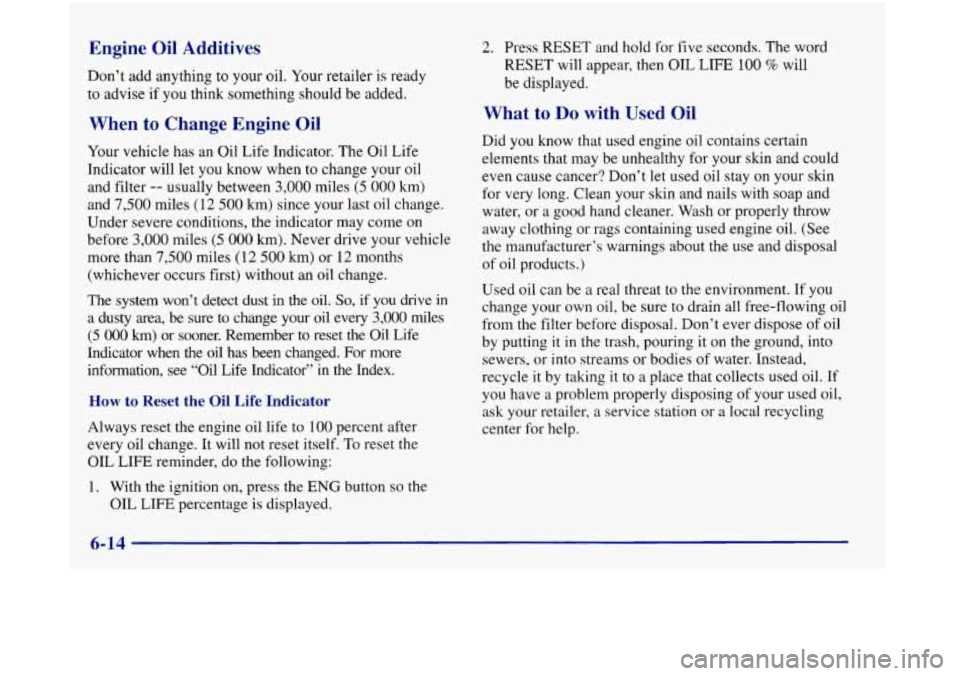
Engine Oil Additives
Don’t add anything to your oil. Your retailer is ready
to advise if you think something should be added. 2. Press
RESET and
hold for five seconds. The word
RESET will appear, then OIL LIFE 100 % will
be displayed.
When to Change Engine Oil
Your vehicle has an Oil Life Indicator. The Oil Life
Indicator will let you know when to change your oil
and filter
-- usually between 3,000 miles (5 000 km)
and
7,500 miles (12 500 km) since your last oil change.
Under severe conditions, the indicator may come on
before
3,000 miles (5 000 km). Never drive your vehicle
more than
7,500 miles (12 500 km) or 12 months
(whichever occurs first) without an oil change.
The system won’t detect dust in the oil. So, if you drive in
a dusty area, be sure to change your oil every 3,000 miles
(5 000 km) or sooner. Remember to reset the Oil Life
Indicator when the oil has been changed. For more
information, see “Oil Life Indicator” in the Index.
How to Reset the Oil Life Indicator
Always reset the engine oil life to 100 percent after
every oil change.
It will not reset itself. To reset the
OIL LIFE reminder, do the following:
1. With the ignition on, press the
ENG button so the
OIL LIFE percentage
is displayed.
What to Do with Used Oil
Did you know that used engine oil contains certain
elements that may be unhealthy for your
skin and could
even cause cancer? Don’t let used oil stay on your skin
for very long. Clean your skin and nails with soap and
water, or a good hand cleaner. Wash or properly throw
away clothing or rags containing used engine oil. (See
the manufacturer’s warnings about the use and disposal
of oil products.)
Used oil can be a real threat to the environment. If you
change your own oil, be sure to drain all free-flowing oil
from the filter before disposal. Don’t ever dispose of oil
by putting
it in the trash, pouring it on the ground, into
sewers, or into streams or bodies of water. Instead,
recycle it by taking it to a place that collects used oil. If
you have a problem properly disposing of your used oil,
ask your retailer, a service station or a local recycling
center for help.
6-14
Page 269 of 380

6. Remove the air filter.
7. Install the new air filter and reverse all steps to
reinstall the cover, electrical wires, hose and clamp.
Be sure the tabs of
the air cleaner cover fit into the
slots
of the air cleaner housing. Then make sure both
clamps are fully engaged.
Refer to the Maintenance Schedule to determine when to
replace the air filter.
See “Scheduled Maintenance Services” in the Index.
I
Operating the engine with the air cleaner off can
cause you
or others to be burned. The air cleaner
not only cleans the air, it stops flame if the engine
backfires.
If it isn’t there, and the engine
backfires, you could be burned. Don’t drive with
it
off, and be careful working on the engine with
the air cleaner
off.
1 NOTICE: I
If the air cleaner is off, a backfire can cause a
damaging engine fire. And, dirt can easily get
into your engine, which will damage it. Always
have the air cleaner in place when you’re driving.
6-17
Page 270 of 380

Automatic Transaxle Fluid
When to Check and Change
A good time to check your automatic transaxle fluid
level is when the engine oil
is changed.
Change both the fluid and filter every
50,000 miles
(83 000 km) if the vehicle is mainly driven under one
or more of these conditions:
In heavy city traffic where the outside temperature
regularly reaches
90°F (32°C) or higher.
In hilly or mountainous terrain.
When doing frequent trailer towing.
Uses such as found in taxi, police or delivery service.
If you do not use your vehicle under any
of these
conditions, the fluid and filter do not require changing.
See “Scheduled Maintenance Services’’ in
the Index.
How to Check
Because this operation can be a little difficult, you may
choose to have this done at your Aurora retail facility
Service Department.
If
you do it yourself, be sure to follow all the
instructions here, or you could get a false reading
on the dipstick.
I
NOTICE:
Too much or too little fluid can damage your
transaxle.
Too much can mean that some of the
fluid could come out and fall on hot engine parts
or exhaust system parts, starting a
fire. Be sure to
get an accurate reading if you check your
transaxle fluid.
6-18